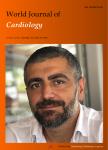Intimal pericytes as the second line of immune defence in atherosclerosis
Intimal pericytes as the second line of immune defence in atherosclerosis作者机构:Department of Development and Regeneration Biomedical Sciences Group KU LeuveLeuvenBelgium Faculty of Medicine School of Medical Sciences University of New South Wales School of Medicine University of Western Sydney Laboratory of Angiopathology Institute of General Pathology and Pathophysiology Russian Academy of Sciences Institute for Atherosclerosis Research Skolkovo Innovative Center Department of Biophysics Faculty of Biology Lomonosov Moscow State University
出 版 物:《World Journal of Cardiology》 (世界心脏病学杂志(英文版)(电子版))
年 卷 期:2015年第7卷第10期
页 面:583-593页
学科分类:1002[医学-临床医学] 100201[医学-内科学(含:心血管病、血液病、呼吸系病、消化系病、内分泌与代谢病、肾病、风湿病、传染病)] 10[医学]
基 金:Supported by The Russian Scientific Foundation Moscow Russian Federation No.14-15-00112
主 题:Atherosclerosis Arteries Intima Immune-inflammator
摘 要:Inflammation plays an essential role in the development of atherosclerosis. The initiation and growth of atherosclerotic plaques is accompanied by recruitment of inflammatory and precursor cells from the bloodstream and their differentiation towards pro-inflammatory phenotypes. This process is orchestrated by the production of a number of pro-inflammatory cytokines and chemokines. Human arterial intima consists of structurally distinct leaflets, with a proteoglycan-rich layer lying immediately below the endothelial lining. Recent studies reveal the important role of stellate pericyte-like cells(intimal pericytes) populating the proteoglycan-rich layer in the development of atherosclerosis. During the pathologic process, intimal pericytes may participate in the recruitment of inflammatory cells by producing signalling molecules and play a role in the antigen presentation. Intimal pericytes are also involved in lipid accumulation and the formation of foam cells. This review focuses on the role of pericytelike cells in the development of atherosclerotic lesions.



